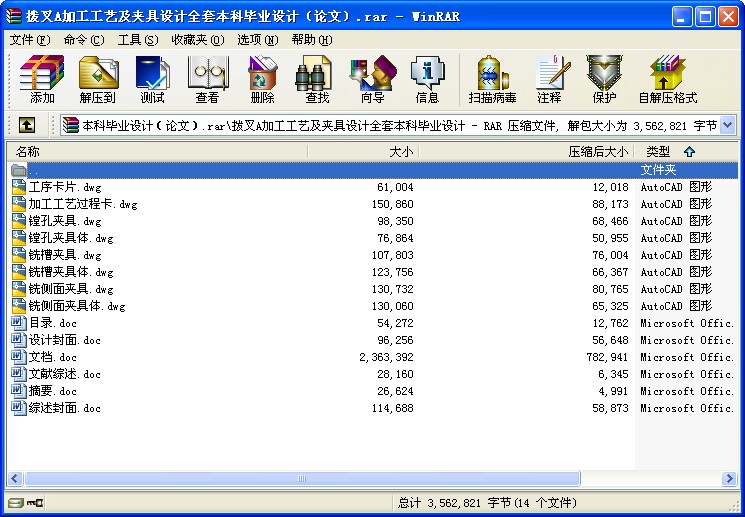撥叉A加工工藝及夾具設計全套本科畢業設計
- 文件介紹:
- 該文件為 rar 格式(源文件可編輯),下載需要
20 積分
-

- 撥叉A加工工藝及夾具設計全套本科畢業設計
摘 要
本設計是車床撥叉零件的加工工藝及專用夾具設計。從零件的結構外型分析,它的外型復雜,且不易加工,因此該零件選用是鑄造件。它的主要加工面是孔、撥叉叉口兩端面和槽,在加工中由于面的加工精度要比孔的加工精度容易保證。因此,在設計中采用先面后孔的原則,并將孔與平面的加工劃分為粗加工和精加工階段,以保證加工精度。在本設計中,先以一個面加工出一個基準面,然后,再以該基準面加工相應的孔。在后面的工序中,均以該孔為定位基準,加工撥叉叉口兩端面、孔、底平面、槽和斜平面,在整個加工過程中,分別采用了銑床、鉆床和鏜床。并設計了銑側面、鏜孔和銑槽等的專用夾具,并對它們的定位都采用了一面兩銷定位。由于該零件的尺寸不大,所需的夾緊力不大。因此,夾緊方式都采用手動夾緊,它的夾緊簡單,機構的設計更為方便,滿足夾緊要求。
關鍵詞 撥叉零件,加工工藝,專用夾具,定位, 夾緊
ABSTRACT
This design is a lather plectrum parts processing and special fixture designs. Parts from the appearance of the structure, its appearance complex and difficult process, so the selection of parts is casting.The parts are cast parts. In the processing, it is easier to ensure the processing accuracy of plane than the hole. So the parts’ main planes are hole, two blades of the Plectrum and groove. Therefore, in the design, it adopts the principle of plane first and hole second and divides the hole and plane’s working into extensive and intensive processing stages so as to ensure the accuracy. In this design, firstly, it uses the plane to work a datum; secondly, it uses the datum to work according hole. And in the latter process of working, it also takes hole as the poisoning base and works the two bales of Plectrum, hole, bottom plane, groove and inclined plane. In the entire machining process, it uses separately the milling machine, driller and boring machine. And the design aspect of milling, boring and milling ducts special fixture. They also have adopted the positioning of a two marketing positioning. According to the requirement, it designs the special fixture. For the size of parts is not very big, it doesn’t require strong clamping force. Therefore, methods of clamping are manual clamping; that is because it is simple and the design is more convenient to meet the requirements of clamping.
Keywords Plectrum Parts, Processing, Special Fixture, Positioning, Clamping
目 錄
摘 要………………………………………………………………………………………Ⅰ
ABSTRACT…………………………………………………………………………………… Ⅱ
1 緒論……………………………………………………………………………………………1
2 撥叉A的分析…………………………………………………………………………………2
2.1零件的作用…………………………………………………………………………………… 2
2.2撥叉A的工藝分析……………………………………………………………………………2
2.3撥叉A的工藝要求……………………………………………………………………………2
2.3.1加工要求……………………………………………………………………………2
2.3.2平面的加工………………………………………………………………………………3
2.3.3大頭孔的加工…………………………………………………………………………3
2.3.4 小頭孔的加工……………………………………………………………………………3
2.4本章小結……………………………………………………………………………………3
3 工藝規程設計…………………………………………………………………………………5
3.1確定毛坯的尺寸形式…………………………………………………………………………5
3.2加工工藝過程…………………………………………………………………………………5
3.3定位基準的選…………………………………………………………………………………5
3.3.1粗基準的選擇……………………………………………………………………………5
3.3.2 精基準的選擇………………………………………………………………………6
3.4工藝路線的擬訂………………………………………………………………………………6
3.4.1確定工序的原則…………………………………………………………………………6
3.4.2工序的特點………………………………………………………………………7
3.4.3加工精度的劃分…………………………………………………………………………8
3.4.4制定工藝路線…………………………………………………………………………8
3.5本章小結…………………………………………………………………………………10
4 工序參數選擇、計算………………………………………………………………………11
4.1毛坯的確定……………………………………………………………………………11
4.1.1毛坯的工藝要求………………………………………………………………………11
4.1.2 毛坯形狀、尺寸要求……………………………………………………………………11
4.2 撥叉A偏差的計算…………………………………………………………………………12
4.2.1 撥叉平面的偏差及加工余量計算……………………………………………………12
4.2.2 大小頭孔的偏差及加工余量計算……………………………………………………13
4.2.3銑 槽的偏差及加工余量計算…………………………………………………14
4.3確定切削用量及基本工時…………………………………………………………………14
4.3.1粗、精加工小頭孔端面…………………………………………………………………14
4.3.2加工孔 到要求尺寸………………………………………………………………16
4.3.3粗、精銑叉口兩側面……………………………………………………………………20
4.3.4粗、精鏜 孔…………………………………………………………………………22
4.3.5粗、精銑下平面…………………………………………………………………………23
4.3.6 粗、 精銑 槽……………………………………………………………………25
4.3.7粗銑斜平面…………………………………………………………………………26
4.3.8銑斷……………………………………………………………………………………26
4.4時間定額計算及生產要求…………………………………………………………………26
4.4.1粗、精加工小頭孔端面…………………………………………………………………27
4.4.2加工孔 到要求尺寸………………………………………………………………27
4.4.3粗、精銑叉口兩側面……………………………………………………………………27
4.4.4粗、精鏜 孔…………………………………………………………………………28
4.4.5粗、精銑下平面…………………………………………………………………………28
4.4.6粗、精銑 槽………………………………………………………………………29
4.4.7粗銑斜平面…………………………………………………………………………30
4.4.8銑斷……………………………………………………………………………………30
4.5本章小結……………………………………………………………………………30
5 鏜孔夾具設計………………………………………………………………………………31
5.1鏜孔夾具設計………………………………………………………………………………31
5.1問題的提出……………………………………………………………………………31
5.2定位基準的選擇…………………………………………………………………………31
5.3夾具方案的確定…………………………………………………………………………32
5.4誤差分析與計算…………………………………………………………………………33
5.5 切削力及夾緊力的計算……………………………………………………………………35
5.6 鏜床夾具分析………………………………………………………………………………37
5.7 本章小結……………………………………………………………………………………38
6銑側面夾具設計……………………………………………………………………39
6.1定位基準的選擇…………………………………………………………………………39
6.2 夾具方案的確定……………………………………………………………………………40
6.3 定位誤差的分析及計算……………………………………………………………………40
6.4切削力及夾緊力的計算…………………………………………………………………41
6.5定向鍵與對刀裝置的選擇………………………………………………………………42
6.6 本章小結……………………………………………………………………………………44
7銑槽夾具設計……………………………………………………………………………45
7.1定位基準的選擇…………………………………………………………………………45
7.2制定夾具設計方案………………………………………………………………………45
7.3定位元件的選擇…………………………………………………………………………47
7.4定位誤差分析…………………………………………………………………………48
7.5銑削力與夾緊力計算……………………………………………………………………49
7.6定向鍵與對刀裝置的選擇………………………………………………………………50
7.7本章小結…………………………………………………………………………………52
8 結論 …………………………………………………………………………………………53
參考文獻………………………………………………………………………………………54
致謝……………………………………………………………………………………………55
...
文檔留言 共有條評論

 熱門關鍵詞:
熱門關鍵詞:


 豫公網安備 41072402000322號
豫公網安備 41072402000322號

